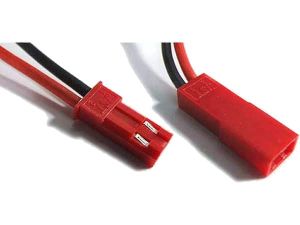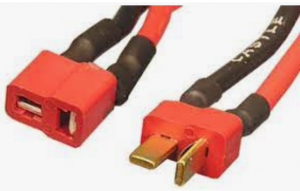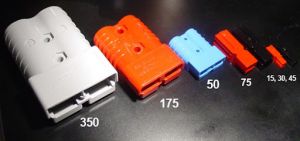Connectors
In combat robotics we use connectors to rapidly disconnect and replace damaged parts such as batteries, motors, servos, and subassemblies (such as removable weapon modules). Repairs between rounds go more smoothly if you have replacement items standing by with connectors already attached and ready to go.
Applications
The most important connectors may be the ones on your battery. You'll need to be able to remove and refresh batteries between matches so your bot doesn't weaken as the competition goes on. While some kit bots permit easy plug-in charging, swapping in a fresh battery will get your bot to 100% immediately.
Another common bot failure is motors. If you can spare the weight, add motor connectors to your bot's motors and all the spares; this will drastically decrease swap and repair time. Just be aware that most connectors only plug together in one direction. If you won't be able to switch motor wires to fix polarity problems, you will need to know how to reverse the direction of a motor on your transmitter or ESC instead.
If your bot has a servo, try to leave its cable intact. That way, if a servo fails or its gears break, you can bolt in a spare servo and just plug it in.
Terminology
- Male and Female connectors: Most connectors have a 'Male' connector type and a 'Female' connector type. There are a few reasons for this design approach. The connectors on the power-source side (battery) are typically 'Female' which means they receive the 'Male' connector which houses the electrical contacts inside the connector. This reduces the likelihood of a battery's connector touching something and short-circuiting by accident.
- Polarized: Many connectors are not symmetrical which means they will only plug into each other in one direction. This ensures that the positive and negative sides of the battery are not accidentally reversed. (On some connectors, if you push hard enough you can still connect them backwards, so do look at the connectors while plugging them together.)
- Crimped / Soldered: Wires need to be secured to the connector pins. This can be done physically by crushing the pin with a specialized crimping tool, or by soldering the wire to the connector. Pins are usually (but not always) designed to do only one or the other.
- Anti-Spark: At higher voltages, electricity can arc across the connector. This damages the surface of the connector pins, which increases resistance and reduces their efficiency. Arc can even damage electronics. Some connectors are designed to reduce this effect. Although anti-sparking connectors can be more expensive, they are typically a better choice at high voltages.
Connector Types
The following are some of the most common connectors used in combat robotics.
- JR, Futaba, DuPont: The connectors used on small servos are called by various names. Nearly all are pre-crimped to small wires, and it's cheap to buy spare cables and use them for repairs. The wires and connectors don't carry much power, and they invariably have generic connectors that can be easily reversed by mistake. On radio-controlled equipment these are usually 3-pin connectors that plug straight into the Rx (receiver). For combat bots, taping these connectors together may be a wise choice.
- JST RCY[1]: (Often called "JST", the name of the manufacturer.) These 3 amp, 2-pin crimp connectors are often seen on small Lipo batteries, and are frequently used in 150g or 1lb small robots. It's easiest to buy these with wires pre-attached for convenience (no need to own a crimping tool). Instead of the smaller 22 gauge wire, look for ones that have at least 20 gauge wire, which will easily handle 5 amps. They have only a tiny latch to hold them together, so you might want to physically secure them with tape or a zip-tie.
- Amass XT: The XT series connector style is popular because they are fairly compact and can handle high current. They come in 30, 60, and 90 amp versions but can handle more than their rated current for short periods of time. Additionally XT connectors come in anti-spark versions which are especially useful in high voltage applications. In combat robotics, the solder-cup types (XT30-U, XT60 and XT60H, and XT90H) are commonly used and require wires to be soldered to the pins. The connectors have a fair amount of thermal mass which can require a bit of practice with a quality soldering iron to make a good connection. Sometimes called "HeXTronik."
- Amass MR: The MR30 and MR60 series connectors have 3 pins and are used to make brushless motor disconnects.
- Anderson PowerPole: This older style connector is still very popular and comes in a range of physical sizes that are rated to handle between 15 and 350 amps. These connectors also have the advantage of a strong physical connection when plugged in. Although you can solder wires into these connectors, they are designed to be crimped.
- Bullet: These single-pin connectors come in various sizes to handle different current. They are good for brushless motors because it's easy to switch two of the wires to change the motor direction. They take up little space, but their physical connection can be weak. Like other connectors, securing them with tape or heat-shrink tubing will help prevent power loss during a match. The XT150 is one of the largest types, carrying up to 130 amps continuously.
Guides
Bunny of Team Malice has created a great connector guide.


